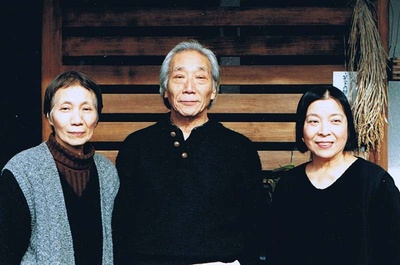Even long after I’ve seen them, some of the sculptured figures that artist Kimiko Koyanagi has created haunt me in the way their long vertical lines rise upward and finding their nadir of expression in faces that are contemplative, inward feeling, seeking some kind of inner peace.
What I find most striking about her creations is the lines she creates. Anyone who has ever looked at the brush strokes of Zen master Hakuin Ekaku (1685-1768) or swordsman/artist Miyamoto Musashi (1584-1645) can see the bold, powerful energy contained in each stroke. As simple as ‘a line’ might seem, profound truth can be contained in a single stroke, just as it can be contained in a tenkan or sword cut too.
Kimiko-san’s sculptures have this ability to make one pause. For me, the lines of her elongated female figures possess an energy, a ‘ki ’, which is an eloquent expression of the artist herself: an ex-pat Japanese living in Burlington, Ontario since 1966, a wife and mother (Eric Kyo, a film maker living in Los Angeles, California, and Marc Gyo, an investment banker with Merrill Lynch in London, England), whose art has evolved into something uniquely Nikkei. While there is something exquisitely Japanese about the designs of her creation’s kimonos, something eternally youthful about the straight bang cut and serene face, they are, in all of their complexity, expressions of her life philosophy: “taeru ”, to bear one’s existence without a smile, bitterness or resentment.
Kimiko-san, 77, was born into the Muraoka doll making family of Itabashi-ku, Tokyo. This is a craft that her artistic parents, Hatsutaro and Kane, carried on from her grandparents, Ginzo and Yoshi Komiya (on her mother’s side) and what has been passed on to her nephews, Kazuhiko and Fumihiko, the fourth generation. From a young girl, she remembers working in her parent’s work shop. For the first 15 years, she only watched her parents and older siblings work. Her father carried on the glass blowing tradition for his father, Tatsugoro. After her long apprenticeship, she practiced the traditional methods, but soon became restless to find her own artistic way: she broke with tradition.
Before she met her Canadian Nisei husband, architect Jim Koyanagi in the early 1960s when he was working in Tokyo, Kimiko-san had won prizes for her work in All Japan Exhibitions in 1956 and 1963. Japan was still in the midst of rebuilding after being flattened in World War Two. The 1964 Tokyo Olympics was to signal to the world Japan’s rise from the ashes of defeat.
"I was a good girl," she recalls smiling, "I worked hard but I always wanted to do my own style. I did my first public competition at 23. I wasn't 100 per cent happy just creating dolls. I also wanted to study woodblock making and stage work but my family was very traditional. I had so many questions. So many educated people then looked down on dolls."
"People usually think about painting or sculpture as ‘art’ but for me some sculpture is nothing and the same is with painting. Some dolls can reach the level of art. I still have difficulty deciding what is 'art'. I hate it when people say 'o ningyo-san' , girls toy maker. When I insist that it is more than a doll, this is too strange for them."
So, are you a Canadian or Japanese artist then?
"I'm both," she says affirmatively. “Before, I didn't feel that I had two feet in this country. I always felt that I had to be Canadian. I have to be here. Then, Japan was pushed away. The first 10-15 years were difficult. I can now see the good and bad part of both Canada and Japan. Before that I was always in the middle somewhere in the Pacific, not belonging to Canada or Japan. Now I can have both."
"In Japan, I was a very confused, lonely girl from a warm family. My feelings were inside. In Japan, I could express my loneliness smoothly but here I can't. Even in the small streets in Japan, I remember the small stones being very pretty but here there are a lot of stones but they aren't pretty to me."
"Here there is more space and clean air. In Japan, even stones and streets are pretty because I grew up over there. I didn't realize this when I was in Japan. With time and distance, I became a ‘visitor’. It's a different way to feel. When I was in Japan it was different. Still, I am not sure. Distance from Japan changed my feelings. Maybe I’m lonely away from Japan, but I understand things differently. I can see more. I can see Japan more clearly."
For me, these understated, elegant creations are expressions of the loss, regret, nostalgia, contentment, and, above all, the strength of spirit that is, ultimately, the artist herself.
* * *
Kimiko, her brother Shigeru (Tokyo), 74, and sister Michiko (La Jolla, California), 72, will be having a show of their work at The Agabe Gallery located in Tokyo. It is entitled “Ningyo San-nin Kyodai-ten” (“Sculptured dolls by the Muraoka brother and sisters”). The show will take place from February 2 to 7, 2010. The gallery is located at Ginza Kyokai 1F, 4-21 Ginza, Chuo-ku. It is walking distance from Yurakucho Station.
* Norm always welcomes your comments at masaji777@gmail.com
** This article was originally published in the November 2009 Nikkei Voice.
© 2009 Norm Ibuki






